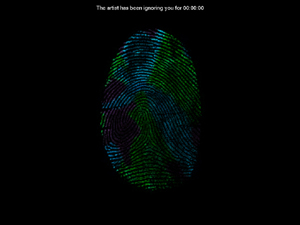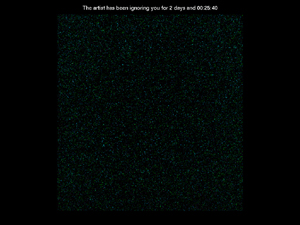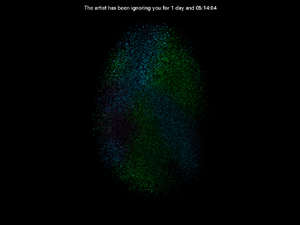TeleAbsence
Connected Installation, 2005
 This work enables the artist to project his presence to the exhibition space from remote locations. He performs remote, digital upkeep on the piece, and so maintains his relationship with the viewer. If he forgets or neglects to do this, his telepresence will fade into TeleAbsence.
This work enables the artist to project his presence to the exhibition space from remote locations. He performs remote, digital upkeep on the piece, and so maintains his relationship with the viewer. If he forgets or neglects to do this, his telepresence will fade into TeleAbsence.
When a work of art is displayed, the artist's name is usually displayed nearby, sometimes along with an explanation of the artist's motivations for the piece, the message the piece conveys, or even a short biography of the artist. This arrangement conjures the artist's presence, suggesting that he himself is partially there, standing before and speaking to the viewer through his work. Of course, in reality, the artist is usually not in the exhibition space. In fact, while his work is engaging and conversing with the visitors, he may be completely oblivious to their existence, for surely he will not be thinking about all of his pieces on display in all parts of the world all the time any more than he will be physically present in all of those locations.
In this piece, a wall-mounted screen displays a hand-colored scan of the artist's fingerprint as a mark of the artist's presence. Over time, the software that displays this image causes it to slowly decay until only static remains on the screen. The decay can only be reversed by the artist, who can connect to the piece over the Internet and restore the image to its original, intended state. The screen also displays a status message about the artist's remote activities, stating "The artist has been ignoring you for X minutes/hours/days," where X is the amount of time since the artist last reset the decay. A cable runs from the screen to an obscured location where it connects the work to the Internet. The cable is secured along the wall in a snaking path, symbolizing the many turns on the path the artist's presence must travel over the Internet from his remote location to the exhibition space.
Click any image on the page for a larger version.

The original image

Complete decay

Getting fuzzier...
 This work enables the artist to project his presence to the exhibition space from remote locations. He performs remote, digital upkeep on the piece, and so maintains his relationship with the viewer. If he forgets or neglects to do this, his telepresence will fade into TeleAbsence.
This work enables the artist to project his presence to the exhibition space from remote locations. He performs remote, digital upkeep on the piece, and so maintains his relationship with the viewer. If he forgets or neglects to do this, his telepresence will fade into TeleAbsence.

